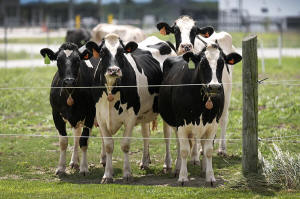Second type of bird flu detected in US dairy cows
 Send a link to a friend
Send a link to a friend
 [February 06, 2025]
By JONEL ALECCIA [February 06, 2025]
By JONEL ALECCIA
Dairy cattle in Nevada have been infected with a new type of bird flu
that's different from the version that has spread in U.S. herds since
last year, Agriculture Department officials said Wednesday.
The detection indicates that distinct forms of the virus known as Type A
H5N1 have spilled over from wild birds into cattle at least twice.
Experts said it raises new questions about wider spread and the
difficulty of controlling infections in animals and the people who work
closely with them.
“I always thought one bird-to-cow transmission was a very rare event.
Seems that may not be the case,” said Richard Webby, an influenza expert
at St. Jude Children’s Research Hospital.
A version of the H5N1 bird flu virus known as B3.13 was confirmed in
March after being introduced to cattle in late 2023, scientists said. It
has infected more than 950 herds in 16 states. The new version, known as
D1.1, was confirmed in Nevada cattle on Friday, according to USDA. It
was detected in milk collected as part of a surveillance program
launched in December.
“Now we know why it's really important to test and continue testing,”
said Angela Rasmussen, a virus expert at the University of Saskatchewan
in Canada, who helped identify the first spillover.
The D1.1 version of the virus was the type linked to the first U.S.
death tied to bird flu and a severe illness in Canada. A person in
Louisiana died in January after developing severe respiratory symptoms
following contact with wild and backyard birds. In British Columbia, a
teen girl was hospitalized for months with a virus traced to poultry.

[to top of second column]
|

Dairy cows stand in a field outside of a milking barn at the U.S.
Department of Agriculture's National Animal Disease Center research
facility in Ames, Iowa, on Tuesday, Aug. 6, 2024. (AP Photo/Charlie
Neibergall,File)
 At least 67 people in the U.S. have
been infected with bird flu, mostly those who work closely with
dairy or cattle, according to the U.S. Centers for Disease Control
and Prevention.
USDA officials said they would post genetic sequences and other
information about the new form of the virus to a public repository
later this week. Scientists said that would be key to understanding
whether the spillover was a recent event or whether the virus has
been circulating, perhaps widely, for longer.
“If this turns out to have been something that crossed into cattle a
couple months ago, a couple months is a long time not to detect it,”
said Michael Worobey, an evolutionary biologist at the University of
Arizona who has studied the H5N1 virus in cattle.
He added that it's important for federal officials to share promptly
information about a virus that has the potential to trigger a
pandemic that could “make COVID seem like a walk in the park.”
“It's a vital part of national security, global security, the
well-being of people, of animals and of businesses in the U.S.,”
Worobey added.
All contents © copyright 2025 Associated Press. All rights reserved |